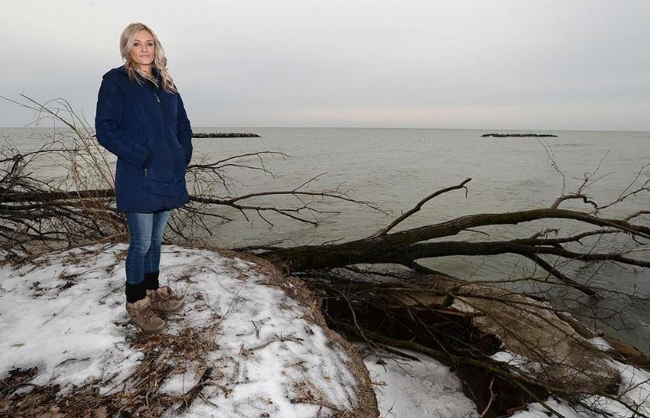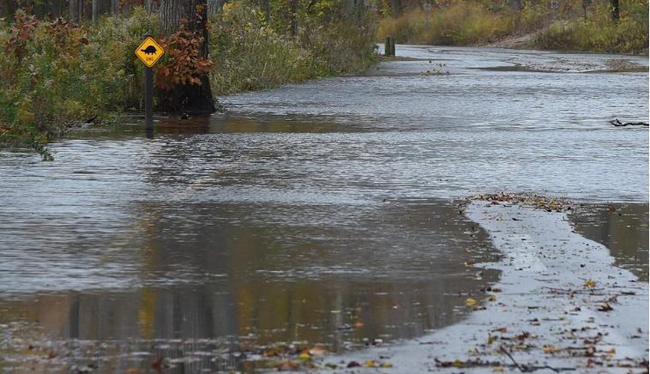
Sara Stahlman, extension lead for Pennsylvania Sea Grant and chair of the Community Resilience Action Network of Erie, is shown near Beach 6 at Presque Isle State Park. There have been erosion problems at the park this winter because of high water levels and a lack of ice on Lake Erie. Credit: Jack Hanrahan/Erie Times-News
— By Valeries Myers, GoErie.com
ERIE, PA, February 15, 2020 - The plan will assess risks to Erie County properties, businesses and natural resources and propose ways to reduce them.
A storm packing strong wind and heavy rain flooded roads, downed trees and power lines, and ate away more of the Lake Erie shoreline last Halloween.
Damage to some two dozen lakefront properties in North East Township alone totaled more than $2.6 million and prompted a federal disaster declaration for Erie County.

High wind and heavy rain knocked down trees and flooded areas of Presque Isle State Park, including the road near Stone Jetty Beach, above, on October 31st and November 1st, 2019. The same storm damaged dozens of lakefront homes and businesses and led to a federal disaster declaration for Erie County. Credit: Jack Hanrahan/Erie Times-News
In 2017, a Christmas Day storm dumped a 24-hour-record 32.6 inches of snow on the region.
Such severe storms have been a “wake-up call” for the region, said Sara Stahlman, of Pennsylvania Sea Grant. Stahlman is chairing a project to assess the tolls that severe weather might take on natural assets, infrastructure, transportation, agriculture and tourism in Erie County and to recommend steps to prepare for and minimize damage.
“Our properties and livelihoods are at risk from extreme weather. We need to be aware of the dangers, be prepared for them and be prepared to bounce back when they happen,” Stahlman said.
Sea Grant and the Community Resilience Action Network of Erie, known as C.R.A.N.E., are beginning work on the “New Normal” climate resilience plan with $38,000 in funding from the National Oceanic and Atmospheric Administration, Great Lakes Integrated Sciences and Assessments and Erie Insurance.
The plan will “dial down” state and national weather data for specifics on Erie County, Stahlman said.
Local officials, farmers, business leaders and others will identify and rank extreme weather risks based on a model developed by New York Sea Grant, Stahlman said.
Strategies to address the risks identified in the Coastal Resilience Index will be presented in public meetings this fall.
Some of the strategies might be as simple as building a rain garden to catch and filter stormwater to reduce flooding and stream contamination, Stahlman said.
“There will be realistic strategies that a municipality, a homeowner or a resident can use.”
The climate resilience plan will consider not only extreme storms but longer-term climate events, including warming.
The average temperature in Erie has increased as much as 4.06 degrees since 1970, according to Climate Central, an organization of climate scientists. The organization ranks Erie at No. 8 among the fastest warming cities in the country.
“We need to look at what the impact of heat is going to be on buildings and the people inside them, especially vulnerable populations, including low-income people, children and the elderly,” said Guy McUmber, director of the Green Building Alliance in northwestern Pennsylvania. “We need to look at ways to mitigate the heat, through air conditioning, better insulation and other building adaptations.”
Rising temperatures also affect growing seasons, flea and tick populations, fish, bird and insect migrations, recreation and harmful algae blooms that can close beaches.
Warming additionally reduces ice coverage on the Great Lakes, which makes more moisture available to feed lake-effect snowstorms like the monster storms of 2017-18.
The region also is getting wetter.
Rainfall in the Great Lakes region has increased 10 percent since 1901, according to climate scientists’ 2019 “Assessment of the Impacts of Climate Change on the Great Lakes.”
In Pennsylvania, 2018 was the wettest year on record, according to the National Weather Service.
And Lake Erie waters continue to rise. The water level reached 573.49 feet in January, 31 inches above the long-term average, and will continue to rise through May, according to the U.S. Army Corps of Engineers.
The high water is evident at Presque Isle State Park, which is doing its own assessment of ways to lessen the effects of climate change. The assessment is among recommendations of the Pennsylvania Department of Conservation and Natural Resources’ strategic planning process to care for state parks and forests over the next 25 years.
“Presque Isle is the logical place to see the effects of climate change — of heavy storm events, high water and lack of lake ice,” park Manager Matt Greene said in 2019. “Presque Isle is always (affected) by nature. We see the effects of changes faster in the process. We see them in real time.”
The Community Resilience Action Network of Erie, which is leading the Erie County climate resilience project, includes representatives from the Erie County Department of Planning, Green Building Alliance, Pennsylvania Department of Environmental Protection, the Regional Science Consortium and Pennsylvania Sea Grant.
Erie Insurance is helping to fund the climate resilience planning to improve public safety and environmental responsibility, said Ann Scott, the company’s community outreach manager.
“The Coastal Resilience Index research fits directly with these important concerns and we’re pleased to support these efforts. We believe this resiliency planning will help ensure our community is better prepared when severe weather occurs,” Scott said.

Sara Stahlman, extension lead for Pennsylvania Sea Grant and chair of the Community Resilience Action Network of Erie, is shown in her office at Tom Ridge Environmental Center. Credit: Jack Hanrahan/Erie Times-News
More Info: Climate change by the numbers
- 1.6 to 4.06 degrees, increase in Erie temperature since 1970
- 10 percent, increase in Great Lakes region rainfall since 1901
- 63.97 inches, of rainfall statewide in 2018, compared to 40.5-inch annual norm
- 573.49 feet, Lake Erie water level in January, 31 inches above long-term average
More Info: New York Sea Grant
New York Sea Grant (NYSG), a cooperative program of Cornell University
and the State University of New York (SUNY), is one of 34 university-based
programs under the National Oceanic and Atmospheric Administration’s
National Sea Grant College Program.
Since 1971, NYSG has represented a statewide network of integrated
research, education and extension services promoting coastal community
economic vitality, environmental sustainability and citizen awareness
and understanding about the State’s marine and Great Lakes resources.
Through NYSG’s efforts, the combined talents of university scientists
and extension specialists help develop and transfer science-based
information to many coastal user groups—businesses and industries,
federal, state and local government decision-makers and agency managers,
educators, the media and the interested public.
The program maintains Great Lakes offices at Cornell University, SUNY
Buffalo, SUNY Oswego and the Wayne County Cooperative Extension office
in Newark. In the State's marine waters, NYSG has offices at Stony Brook
University in Long Island, Brooklyn College and Cornell Cooperative
Extension in NYC and Kingston in the Hudson Valley.
For updates on Sea Grant activities: www.nyseagrant.org has RSS, Facebook, Twitter, and YouTube links. NYSG offers a free e-list sign up via www.nyseagrant.org/nycoastlines for its flagship publication, NY Coastlines/Currents, which is published quarterly. Our program also produces an occasional e-newsletter,"NOAA Sea Grant's Social Media Review," via its blog, www.nyseagrant.org/blog.